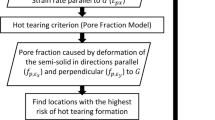Abstract
This paper deals with the comparison of experimentally measured temperature gradients and finite-element-method (FEM) simulations of two heating strategies that were used for continuously cast bloom soaking. The temperature gradient between the bloom surface and center was measured by two thermocouples incorporated directly into the bloom. Scanning electron microscopy equipped by energy dispersive X-ray spectroscopy analysis, hot tensile tests, and interdendritic solidification software was used for modeling of steel thermophysical properties with respect to the alloying-elements macrosegregation. The model of the bloom was programmed in the Fortran language. The FEM software MARC/MENTAT 2012 was used for simulation of two heating strategies (plane strain formulation). The first heating model was fitted to the commonly used heating strategy when internal defects grew above the critical limit. The second heating model was a newly proposed strategy that consisted of slower heating up to 1073 K when the first warming-through period occurred. The FEM simulations included determinations of the temperature gradient, the equivalent of stress, the equivalent of elastic strain, the equivalent of plastic strain, and the equivalent of total strain. The simulation results were in good agreement with experimental observations. The new heating strategy based on the FEM simulations led to significantly lower occurrence of internal defects in hot-rolled billets that are used for cylinder production.






Similar content being viewed by others
References
B. Mintz, R. Abushosha, Ironmak. Steelmak. 20, 6 (1993)
B. Mintz, ISIJ Int. 39, 833 (1999)
T.N. Baker, Mater. Sci. Technol. 25, 9 (2009)
M. Kvíčala, J. Morávka, P. Jandačka, Inžynieria Materialowa 178, 1433 (2010)
A. Hendrych, M. Kvíčala, V. Matolin, O. Životský, P. Jandačka, Int. J. Fract. 168, 259 (2011)
M. Kvíčala, A. Hendrych, O. Životský, P. Jandačka, Acta Metall. Slovaca 16, 2 (2010)
M. Kvíčala, M. Klimek, I. Schindler, Hutnické listy 6, 13 (2009)
J. Miettinen, S. Louhenkilpi, H. Kytonen, J. Laine, Math. Comput. Simul. 80, 7 (2010)
S. Louhenkilpi, J. Miettinen, L. Holappa, ISIJ Int. 46, 6 (2006)
http://www.engineersedge.com/properties_of_metals.htm. Accessed 9 Sept 2013
M.J. Peet, H.S. Hasan, H.K.D.H. Bhadeshia, Int. J. Heat Mass Transf. 54, 2602 (2011)
Acknowledgments
This paper has been elaborated in the framework of the Project Opportunity for Young Researchers, Reg. No. CZ.1.07/2.3.00/30.0016, supported by Operational Programme Education for Competitiveness and co-financed by the European Social Fund and the state budget of the Czech Republic. This paper was created in the Project No. LO1203 “Regional Materials Science and Technology Centre - Feasibility Program” funded by Ministry of Education, Youth and Sports of the Czech Republic.
Author information
Authors and Affiliations
Corresponding author
Rights and permissions
About this article
Cite this article
Kvíčala, M., Frydrýšek, K. & Štamborská, M. Comparison of Experimentally Measured Temperature Gradient and Finite-Element-Method Simulations for Two Continuously Cast Bloom Heating Strategies. Int J Thermophys 36, 508–515 (2015). https://doi.org/10.1007/s10765-014-1823-x
Received:
Accepted:
Published:
Issue Date:
DOI: https://doi.org/10.1007/s10765-014-1823-x




